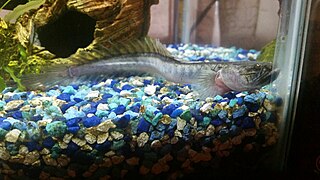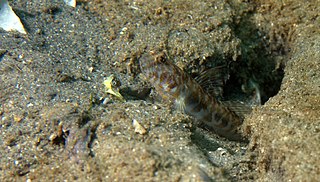
Eleotridae is a family of fish commonly known as sleeper gobies, with about 34 genera and 180 species. Most species are found in the tropical Indo-Pacific region, but there are also species in subtropical and temperate regions, warmer parts of the Americas and near the Atlantic coast in Africa. While many eleotrids pass through a planktonic stage in the sea and some spend their entire lives in the sea; as adults, the majority live in freshwater streams and brackish water. One of its genera, Caecieleotris, is troglobitic. They are especially important as predators in the freshwater stream ecosystems on oceanic islands such as New Zealand and Hawaii that otherwise lack the predatory fish families typical of nearby continents, such as catfish. Anatomically, they are similar to the gobies (Gobiidae), though unlike the majority of gobies, they do not have a pelvic sucker.

Acentrogobius is a genus of gobies native to marine, fresh and brackish waters of the coasts of the Indian Ocean and the western Pacific Ocean.

Glossogobius is a genus of gobies native to fresh, brackish and marine waters from Africa to the coasts of the western Pacific Ocean. They are found in Madagascar, South Africa, Japan, Thailand, Australia, Indonesia, Bangladesh, the Philippines, Taiwan, Papua New Guinea, Singapore, Malawi, Eswatini, Botswana, Kenya, Zimbabwe, Tanzania, Mozambique, the Solomon Islands, Palau, Fiji, New Caledonia, India, Laos, Sri Lanka, Myanmar, Borneo, Nepal, Brunei Darussalam, Micronesia, Cambodia, Vietnam, China, Réunion, the Seychelles, Mauritius, the Caroline Islands, Vanuatu, Malaysia and Russia. The genus also includes a troglobitic species, G. ankaranensis.

Proterorhinus marmoratus is a species of gobiid fish, a tubenose goby native to the brackish water parts of the Black Sea and the Sea of Azov, near the coasts of Bulgaria, Georgia, Romania, Ukraine and Russia. Also it is found in the Marmora Sea (Turkey). It can reach a length of 11.5 centimetres (4.5 in) TL.

Stenogobius is a genus of fish in the goby subfamily, Gobionellinae. They are native to fresh, brackish and marine waters along the coasts of the Indian and Pacific Oceans. They are known commonly as coastal stream gobies.

Elacatinus is a genus of small marine gobies, often known collectively as the neon gobies. Although only one species, E. oceanops, is technically the "neon goby", because of their similar appearance, other members of the genus are generally labeled neon gobies, as well. Except for a single East Pacific species, all reside in warmer parts of the West Atlantic, including the Caribbean and Gulf of Mexico. They are known for engaging in symbiosis with other marine creatures by providing them cleaning service that consists of getting rid of ectoparasites on their bodies. In return, Elacatinus species obtain their primary source of food, ectoparasites.

The Gobiiformes are an order of fish that includes the gobies and their relatives. The order, which was previously considered a suborder of Perciformes, is made up of about 2,211 species that are divided between seven families. Phylogenetic relationships of the Gobiiformes have been elucidated using molecular data. Gobiiforms are primarily small species that live in marine water, but roughly 10% of these species inhabit fresh water. This order is composed chiefly of benthic or burrowing species; like many other benthic fishes, most gobiiforms do not have a gas bladder or any other means of controlling their buoyancy in water, so they must spend most of their time on or near the bottom. Gobiiformes means "goby-like".

The giant goby is a species of goby native to coastal marine and brackish waters of the eastern Atlantic, the Mediterranean Sea and the Black Sea at depths of from 10 to 35 metres. This species is of minor importance to commercial fisheries and is also popular as a game fish.

Lepidogobius lepidus, the bay goby or finescale goby, is a species of goby native to the Pacific coast of North America from British Columbia, Canada to Baja California, Mexico where it can be found on muddy substrates from the intertidal zone to 201 metres (659 ft). This species grows to a length of 10 centimetres (3.9 in) TL. This species is the only known member of its genus.

The grass goby is a species of goby native to the Mediterranean Sea, the Sea of Azov and the Black Sea. It is the only known member of its genus.

The Gobionellinae are a subfamily of fish which was formerly classified in the family Gobiidae, the gobies, but the 5th Edition of Fishes of the World classifies the subfamily as part of the family Oxudercidae. Members of Gobionellinae mostly inhabit estuarine and freshwater habitats; the main exception is the genus Gnatholepis, which live with corals in marine environments. The subfamily is distributed in tropical and temperate regions around the world with the exception of the northeastern Atlantic Ocean, the Mediterranean Sea, and the Ponto-Caspian region. It includes around 370 species and 55 genera: Wikipedia articles about genera list about 389 species.

Rhinogobiops is a genus of true gobies in the family Gobiidae. It is monotypic, being represented by the single species, Rhinogobiops nicholsii, also known as the blackeye goby, bluespot goby, and crested goby. They are common inhabitants of coral reefs and rocky habitats along the eastern Pacific Ocean coasts of Mexico, the United States, and Canada, although they are hardly noticed, as they often rest motionless near their shelters.
Barbulifer is a genus of gobies native to the tropical Atlantic coast of the Americas as well as the Gulf of California on the Pacific coast.

Bollmannia is a genus of gobies native to the Atlantic and Pacific coasts of the Americas. The generic name honours the American naturalist Charles Harvey Bollman (1868–1889).
Chriolepis is a genus of gobies native to the Atlantic and Pacific coasts of the Americas.

The arrow goby is a species of goby native to marine and brackish waters of the Pacific coast of North America from British Columbia to Baja California. This species grows to a length of 6.4 centimetres (2.5 in) SL, though most do not exceed 4.2 centimetres (1.7 in) TL. This fish can also be found displayed in public aquaria. This species is the only known member of its genus.

Gobioides is a genus of gobies native to marine, fresh and brackish waters along the coasts of the Atlantic Ocean and in fresh waters of the Pacific coast of the Americas.
Gobulus is a genus of gobies native to the Atlantic and Pacific coasts of the Americas.

Microgobius is a genus of gobies native to the Pacific and Atlantic coasts of the Americas.

The orangespotted goby is a species of goby native to the tropical Atlantic coast from Bermuda and southern Florida through the Caribbean Sea and Gulf of Mexico south to the Caribbean coasts of Venezuela and Colombia, where it prefers silty bottoms around reefs. It is a commensal with an alpheid shrimp. This species grows to a length of 10 centimetres (3.9 in) TL. This species is the only known member of its genus.

















